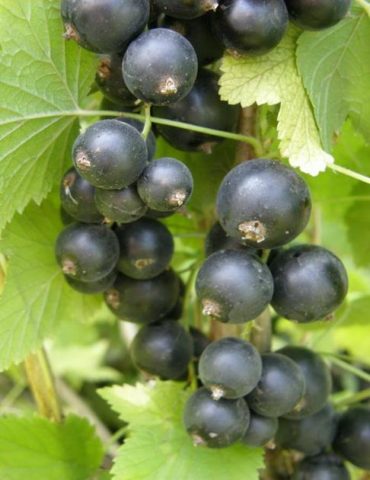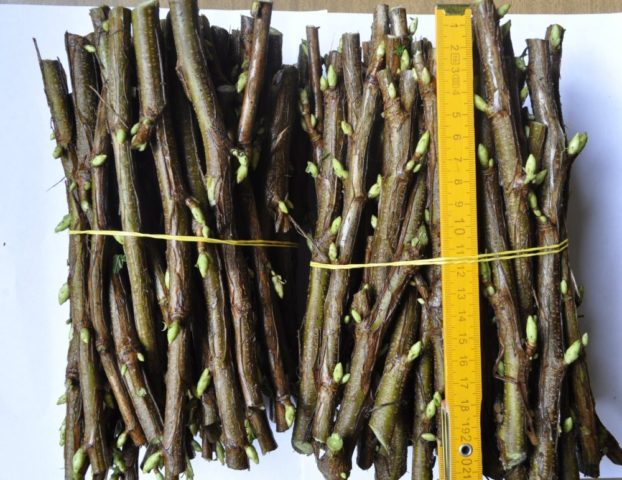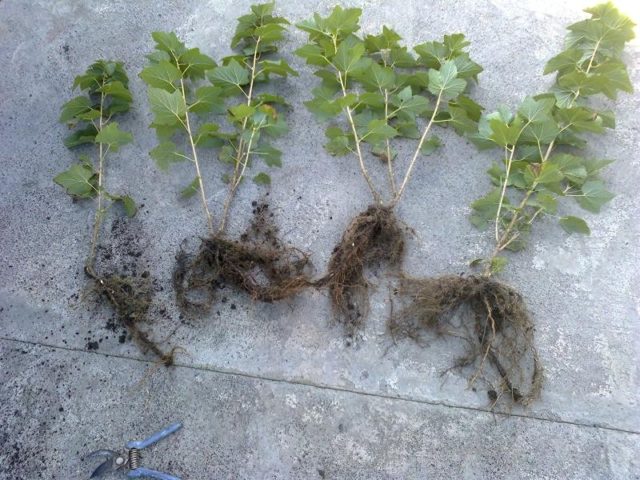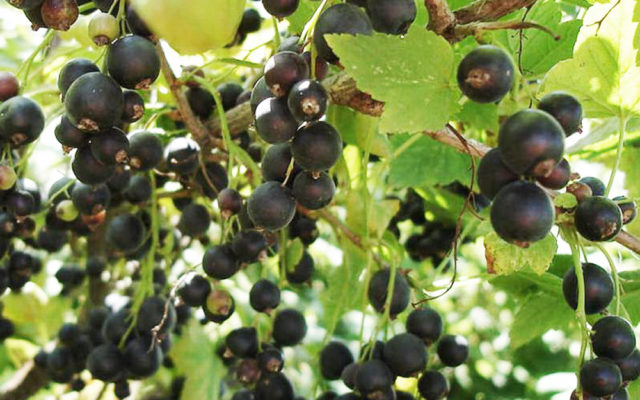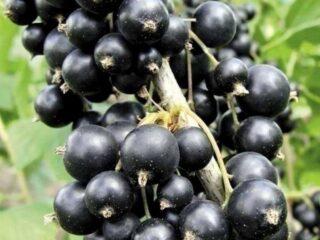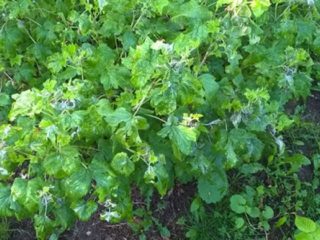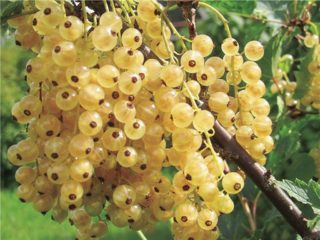Content
The Minx currant is a very early ripening variety that gives a crop one of the first. The plant was bred in the VNIIS them. Michurin. The parent varieties were Dikovinka and Detskoselskaya. In 2006, the Minx currant was included in the State Register of the Russian Federation.
Description of the variety of currant Minx
According to the description of the variety, the black currant Minx is a short, slightly spreading bush. Its shoots are straight, thin, shiny, gray-brown in color. The kidneys are medium in size, reddish, elongated. They are located on the branches one by one.
The Minx variety has five-lobed leaves of medium or small size. Moreover, they are convex, wrinkled, located on the shoots at an angle. Their blades are sharp at the edges, the middle part is longer. The petiole is of medium size, anthocyanin in color, slightly pubescent at the base.
Flowers - goblet-shaped, medium-sized. Sepals are pale in color, with purple stripes along the edges. Brushes - short, straight, 4 to 6 cm long.
The black currant variety Shalunya is recommended for the Central Black Earth Region. When grown in other areas, the bush may freeze in winter.
Description of black currant berries Minx:
- rounded shape;
- black skin with a light waxy coating;
- large sizes;
- weight from 1.5 to 2 g.
The berries of the Minx variety have a good sweet taste. Their tasting score is 4.8 - 5 points. The composition of black currant includes dry and P-active substances, ascorbic acid, pectin. Fruits gain up to 11.5% sugars.
Characteristics
Before buying black currant, Minx analyze its characteristics. Particular attention is paid to resistance to drought and cold weather, yield, quality of berries.
Drought resistance, frost resistance
Black currant Minx has medium drought tolerance. To obtain a harvest, the bush is regularly watered. Its frost resistance is high. Plants do not freeze when the temperature drops to -30 ° C.
Variety yield
Currant varieties Minx gives a harvest in the very early period. The first berries ripen in early June. Up to 3.5 - 4 kg are removed from one bush. The fruits are not baked in the sun and do not crumble. Over time, the size of the berries does not decrease.
The Minx variety is self-fertile. The ovaries are formed without cross-pollination. All berries are aligned, of the same size. Their value does not change during the growing season.
Application area
Blackcurrant Minx for universal use. Berries are used fresh for vitamin cocktails, healthy breakfasts, pie fillings. The variety is also suitable for processing into preserves, jams, compotes.
Berries of the Minx variety tolerate storage and transportation well. At the same time, they retain their taste and do not emit much juice.
Pros and cons of the variety
Benefits of Black Currant Minx:
- early maturity of young bushes;
- high productivity;
- self-fertility;
- sweet dessert taste;
- non-susceptibility to disease.
Disadvantages of currant varieties Minx:
- the need for care;
- medium resistance to spider mites.
Reproduction methods
For propagation of black currant varieties of Minx, vegetative methods are used:
- Cuttings. In the spring, lignified shoots with a thickness of 5 - 8 mm are chosen on the bushes. They are shortened to a length of 20 cm, an oblique cut is made from above, and a straight cut from below. The stalk is stuck into light fertile soil so that two buds remain above the surface. All season they are watered and fed with mineral complexes. In the fall, the currants are dug up and transplanted to a new place;
- Layers. A strong and healthy branch is taken from the Minx currant, which is lowered to the ground and fastened with staples. The soil is poured on top so that the tip of the shoot remains above the surface. Layers are regularly watered, mineral fertilizers are applied to the soil. In the fall, they are separated and planted from the mother bush;
- Division of the rhizome. This method is used when transplanting the black currant Minx or for the purpose of rejuvenating the bush. The rhizome is dug up and divided into parts with a knife. The resulting seedling should have several shoots and strong roots. The slices are sprinkled with wood ash. The seedlings are transferred to a prepared place.
Planting and leaving
In warm climates, black currants are planted in autumn, in October or November and wait for the end of the leaf fall, when the plants go into a state of dormancy. If less than 3 weeks remain before the onset of cold weather, then the work is split off in the spring. The seedling is buried in the ground, sawdust or humus is poured on top.
Black currant grows in different soils. The best results are obtained by growing a bush in a slightly acidic fertile soil. If the land is sandy and light, then organic fertilizers are sure to be used. The acidic soil is limed. The optimum pH is 6.5.
For the Minx variety, a sunny area is chosen, protected from the cold wind. The plant tolerates partial darkening. Places on the west or south side are best suited for planting.
Preparation of the site for black currant begins in the fall. The soil is dug up, cleared of weeds and plant debris. For 1 sq. m, 5 kg of compost or rotted manure, 100 g of superphosphate and 1 liter of wood ash are introduced.
Two-year-old plants with three strong shoots are suitable for planting. The currants should be free of mold, rotten areas, cracks and other defects. 2 - 3 hours before planting, the roots of the Minx seedling are kept in a bucket of water.
The order of planting black currant varieties Minx:
- Dig a hole 60 cm deep and 50 cm in diameter.
- To fill the pit, a substrate is prepared: fertile soil, compost, 50 g of superphosphate, a handful of wood ash.
- On 2/3 the pit is filled with the resulting mixture, then a bucket of water is poured into it.
- After 2 - 3 weeks, when the soil shrinks, fertile soil is poured into the pit.
- A currant seedling is placed on top, the roots are straightened and covered with soil.
- The soil is compacted and watered abundantly.
- Shoots are cut off, 2 - 3 buds are left on each of them.
Follow-up care
By trimming the black currant, a healthy bush is formed. In early spring, during the dormant period, dry, old, broken branches are removed. 5 - 6 strong shoots are left on the bush. Pruning stimulates the emergence of new strong branches that will harvest the next year.
Black currants prefer moderately moist soils. In a drought, the Minx variety is watered every 10 days. A bush requires 20 liters of warm, settled water. Watering is especially important during flowering and crop formation.
Every year black currants are fed with mineral complexes. In the spring, before bud break, ammonium sulfate is used. For 1 sq. m requires 30 g of fertilizer. Then the soil under the bush is mulched with compost or manure. When flowering, currants are watered with a solution containing superphosphate and potassium salt. For 10 l of water add 40 g of each substance.
Preparing for winter will help the Minx blackcurrant survive the cold. In late autumn, before the onset of cold weather, the bush is abundantly watered and covered with earth. Then a layer of humus or peat 10-15 cm thick is poured. For protection from rodents, a metal mesh is used, which is wrapped around the shoots.
Pests and diseases
Currant variety Minx is resistant to fungal diseases. Lesions can appear during cold and rainy summers. The first signs of disease are the appearance of brown or red spots on the leaves and shoots. In this case, the bush is sprayed with Bordeaux liquid, copper oxychloride, solutions of Oxyhom or Topaz preparations.
The Minx variety can be attacked by a spider mite. This is a small pest that is difficult to detect with the naked eye. It is identified by the cobwebs that envelop the leaves and berries. The mite feeds on the sap of the leaves. As a result, black currant develops poorly and does not produce a crop. To combat the pest, the bushes are sprayed with Karate, Antiklesch, Fitoverm preparations.
Conclusion
Minx currant is an excellent variety for the Chernozem region. It is distinguished by early fruiting, high productivity and quality of berries. Caring for the Minx variety includes watering, feeding, pruning the bush. The plant is resistant to drought, diseases and pests.
